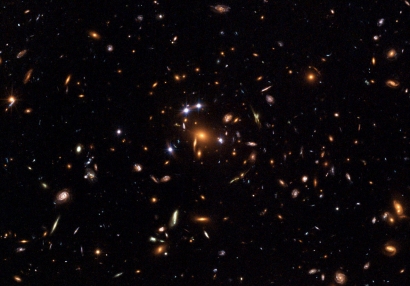Hubble captures a five-star rated gravitational lens [heic0606]
23 May 2006
The NASA/ESA Hubble Space Telescope has captured the first-ever picture of a distant quasar lensed into five images. In addition the picture holds a treasure of lensed galaxies and even a supernova.The most unique feature in this new image is a group of five quasar images produced by gravitational lensing, a process in which the gravitational field of a massive object - in this case, a cluster of galaxies - bends and amplifies light from an object farther behind it.
 |
|
Galaxy cluster SDSS J1004+4112 with five-time lensed quasar |
Although other multiply lensed quasars have been seen before, this newly observed quintuple quasar is the only case so far in which multiple quasar images are produced by an entire galaxy cluster acting as the gravitational lens.
The background quasar is the brilliant core of a galaxy. It is powered by a black hole, which is devouring gas and dust and creating a gusher of light in the process. When the quasar's light passes through the gravity field of the galaxy cluster that lies between us and the quasar, the light is bent by the cluster's gravity field in such a way that five separate images of the quasar are produced surrounding the cluster's centre. The fifth quasar image is embedded to the right of the core of the central galaxy in the cluster. The cluster also creates a cobweb of images of other distant galaxies gravitationally lensed into arcs.
The galaxy cluster forming the lens is SDSS J1004+4112 and was discovered as part of the Sloan Digital Sky Survey. It is one of the more distant clusters known (at seven billion light-years, redshift 0.68), and is seen when the Universe was half its present age.
Gravitational lensing occurs for extremely concentrated masses like the cores of galaxies or galaxy clusters. A gravitational lens will always produce an odd number of lensed images, but one image is usually very weak and embedded deep within the light of the lensing object itself. Though previous observations of SDSS J1004+4112 have revealed four of the images of this system, Hubble's sharp vision and the high magnification of this gravitational lens combine to place a fifth image far enough from the core of the central imaging galaxy to make it visible as well.
The galaxy hosting the background quasar is at a distance of 10 billion light years (at redshift 1.74). The quasar host galaxy can be seen in the image as faint red arcs. This is the most highly magnified quasar host galaxy ever seen.
The Hubble picture also shows a large number of stretched arcs from more distant galaxies lying behind the cluster, each of which is split into multiple distorted images. The most distant galaxy identified and confirmed so far is 12 billion light years away (at a redshift of 3.33, corresponding to only 1.8 billion years after the Big Bang).
By comparing this image to a picture of the cluster obtained with Hubble a year earlier, the researchers discovered a rare event - a supernova exploding in one of the cluster galaxies. This supernova exploded seven billion years ago, and the data, together with other supernova observations, are being used to try to reconstruct how the Universe was enriched by heavy elements through these type of explosions.
# # #
Notes for editors
The Hubble Space Telescope is a project of international cooperation between ESA and NASA.
Image credit: European Space Agency, NASA, Keren Sharon (Tel-Aviv University) and Eran Ofek (CalTech)
Acknowledgements: Davide de Martin (www.skyfactory.org).
The team members are Keren Sharon (Tel-Aviv University, Israel), Eran Ofek (CalTech, USA), Dan Maoz, Tom Broadhurst (Tel-Aviv University, Israel), Chris Kochanek (Ohio State University, USA), Masamune Oguri (Princeton University, USA), Yasushi Suto and Naohisa Inada (University of Tokyo, Japan).
Contacts
Dan Maoz
Tel-Aviv University, Israel
Tel: +972-3-640-8538
E-mail: maoz wise.tau.ac.il
wise.tau.ac.il
Keren Sharon
Tel-Aviv University, Israel
Tel: +97236405121
Email:kerens wise.tau.ac.il
wise.tau.ac.il
Lars Lindberg Christensen
Hubble/ESA, Garching, Germany
Tel: +49(0)89-3200-6306
Cellular: +49-(0)173-3872-621
E-mail:lars eso.org
eso.org
Ray Villard
Space Telescope Science Institute, Baltimore, USA
Tel: +1-410-338-4514
E-mail: villard stsci.edu
stsci.edu

